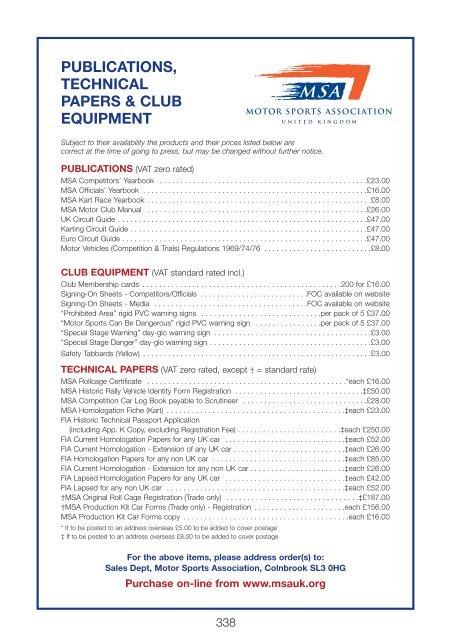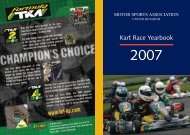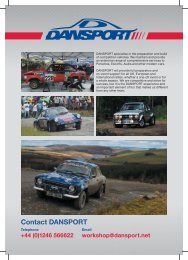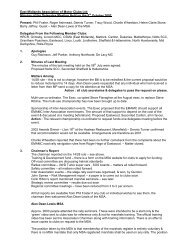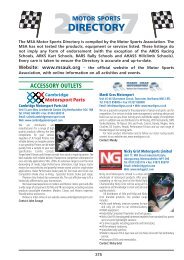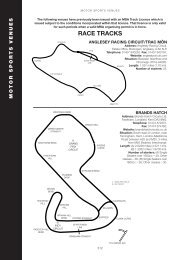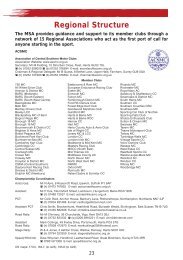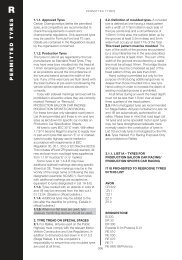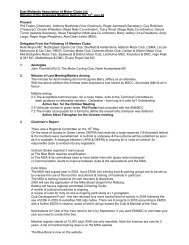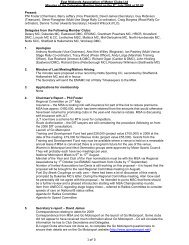Create successful ePaper yourself
Turn your PDF publications into a flip-book with our unique Google optimized e-Paper software.
PUBLICATIONS,TECHNICALPAPERS & CLUBEQUIPMENTSubject to their availability the products and their prices listed below arecorrect at the time of going to press, but may be changed without further notice.PUBLICATIONS (VAT zero rated)MSA Competitors’ Yearbook . . . . . . . . . . . . . . . . . . . . . . . . . . . . . . . . . . . . . . . . . . . . . . . . . .£23.00MSA Officials’ Yearbook . . . . . . . . . . . . . . . . . . . . . . . . . . . . . . . . . . . . . . . . . . . . . . . . . . . . . .£16.00MSA Kart Race Yearbook . . . . . . . . . . . . . . . . . . . . . . . . . . . . . . . . . . . . . . . . . . . . . . . . . . . . . .£8.00MSA Motor Club Manual . . . . . . . . . . . . . . . . . . . . . . . . . . . . . . . . . . . . . . . . . . . . . . . . . . . . .£26.00UK Circuit Guide . . . . . . . . . . . . . . . . . . . . . . . . . . . . . . . . . . . . . . . . . . . . . . . . . . . . . . . . . . . .£47.00<strong>Karting</strong> Circuit Guide . . . . . . . . . . . . . . . . . . . . . . . . . . . . . . . . . . . . . . . . . . . . . . . . . . . . . . . . .£47.00Euro Circuit Guide . . . . . . . . . . . . . . . . . . . . . . . . . . . . . . . . . . . . . . . . . . . . . . . . . . . . . . . . . . .£47.00Motor Vehicles (Competition & Trials) <strong>Regulations</strong> 1969/74/76 . . . . . . . . . . . . . . . . . . . . . . . . . .£8.00CLUB EQUIPMENT (VAT standard rated incl.)Club Membership cards . . . . . . . . . . . . . . . . . . . . . . . . . . . . . . . . . . . . . . . . . . . . . . . .200 <strong>for</strong> £16.00Signing-On Sheets - Competitors/Officials . . . . . . . . . . . . . . . . . . . . . . . . . .FOC available on websiteSigning-On Sheets - Media . . . . . . . . . . . . . . . . . . . . . . . . . . . . . . . . . . . . .FOC available on website“Prohibited Area” rigid PVC warning signs . . . . . . . . . . . . . . . . . . . . . . . . . . . . .per pack of 5 £37.00“Motor Sports Can Be Dangerous” rigid PVC warning sign . . . . . . . . . . . . . . . .per pack of 5 £37.00“Special Stage Warning” day-glo warning sign . . . . . . . . . . . . . . . . . . . . . . . . . . . . . . . . . . . . . .£3.00“Special Stage Danger” day-glo warning sign . . . . . . . . . . . . . . . . . . . . . . . . . . . . . . . . . . . . . . .£3.00Safety Tabbards (Yellow) . . . . . . . . . . . . . . . . . . . . . . . . . . . . . . . . . . . . . . . . . . . . . . . . . . . . . . .£3.00TECHNICAL PAPERS (VAT zero rated, except † = standard rate)MSA Rollcage Certificate . . . . . . . . . . . . . . . . . . . . . . . . . . . . . . . . . . . . . . . . . . . . . . . .*each £16.00MSA Historic Rally Vehicle Identity Form Registration . . . . . . . . . . . . . . . . . . . . . . . . . . . . . . .‡£50.00MSA Competition Car Log Book payable to Scrutineer . . . . . . . . . . . . . . . . . . . . . . . . . . . . . .£28.00MSA Homologation Fiche (Kart) . . . . . . . . . . . . . . . . . . . . . . . . . . . . . . . . . . . . . . . . . . .‡each £23.00FIA Historic Technical Passport Application(including App. K Copy, excluding Registration Fee) . . . . . . . . . . . . . . . . . . . . . . . . .‡each £250.00FIA Current Homologation Papers <strong>for</strong> any UK car . . . . . . . . . . . . . . . . . . . . . . . . . . . . .‡each £52.00FIA Current Homologation - Extension of any UK car . . . . . . . . . . . . . . . . . . . . . . . . . . .‡each £26.00FIA Homologation Papers <strong>for</strong> any non UK car . . . . . . . . . . . . . . . . . . . . . . . . . . . . . . . .‡each £85.00FIA Current Homologation - Extension <strong>for</strong> any non UK car . . . . . . . . . . . . . . . . . . . . . . .‡each £26.00FIA Lapsed Homologation Papers <strong>for</strong> any UK car . . . . . . . . . . . . . . . . . . . . . . . . . . . . .‡each £42.00FIA Lapsed <strong>for</strong> any non UK car . . . . . . . . . . . . . . . . . . . . . . . . . . . . . . . . . . . . . . . . . . .‡each £52.00†MSA Original Roll Cage Registration (Trade only) . . . . . . . . . . . . . . . . . . . . . . . . . . . . . . . .‡£187.00†MSA Production Kit Car Forms (Trade only) - Registration . . . . . . . . . . . . . . . . . . . . . .each £156.00MSA Production Kit Car Forms copy . . . . . . . . . . . . . . . . . . . . . . . . . . . . . . . . . . . . . . . .each £16.00* If to be posted to an address overseas £5.00 to be added to cover postage‡ If to be posted to an address overseas £8.00 to be added to cover postageFor the above items, please address order(s) to:Sales Dept, Motor Sports Association, Colnbrook SL3 0HGPurchase on-line from www.msauk.org338
(N) <strong>Specific</strong> <strong>Regulations</strong> <strong>for</strong> <strong>Karting</strong>K339
<strong>Karting</strong> (N)KFinal year of thehomologationFinal year of thehomologationFIA/WKF 1997 001XXXXXXXXXXXXManufacturer’snameCIK/FIA 99 / 043-200000000000Manufacturer’snameFMK/FIA 2001 000Homologationapplication numberHomologationapplication numberhas obtained six kart race signatures from MSAStewards. Thereafter he can continue to compete on aNational ‘B’ Licence, or can upgrade to a National ‘A’Licence in accordance with E 2.15.12(a) but he will nolonger be considered a novice. Completion of theARKS Course [E 2.3.3] will constitute one of the sixsignatures.12.3. A valid licence/medical certificate must beproduced at signing-on at all events [see E 2.9].12.4. Deleted.12.5. Licence validity: See chart of MinimumAcceptable Licences in Section E.12.5.1. A competitor on long circuits will be consideredas a Novice, and will have to carry a Novice plate [J12.3], until he has received 4 signatures from the MSASteward <strong>for</strong> competing successfully on long circuits.12.6. Deleted.12.7. All competitors who have not reached their 18thbirthday must have the Competition Licenceapplication <strong>for</strong>m counter-signed by a parent or guardianwho will be considered to be the Entrant of the driverand will be responsible <strong>for</strong> their behaviour.12.8. Any competitor who is unable to produce hisLicence/Medical Certificate will be reported to the MSASteward. He might be allowed to compete if he cansatisfy the Steward that the licence is missing becauseof administrative problems and in particular he mustsatisfy the Steward that he has been medicallyexamined and approved. He will be subject to a nonrefundablefine as detailed in Appendix Z.12.9. At all meetings drivers and entrants areresponsible <strong>for</strong> the conduct of their mechanics, helpersand team personnel [E 4.1.9].Final year of thehomologationXXXXXXXXXXXXManufacturer’snameCIK/FIA 2003 001Figure N11Only suits bearing one of the above labels areacceptable as CIK homologated.Homologationapplication numberN 2001-1 ABCDEFGHIJKL Level X01-2001Standards N...Efficiency...Year ofHomologationhomologationnumberName of the manufacturer and manufacturing date12.2. Retaining and Upgrading. Details are given inSection E 2.15.12.12.2.1. A competitor will be considered as a ‘Novice’and must use Novice number plates [14.16.4], until he34713. Class RestrictionsThe age breaks are as defined below. The Class<strong>Regulations</strong> within the Kart Race Yearbook may applyfurther limitations.13.1. Cadet Class. Compulsory class <strong>for</strong> 8-11 year olds.However, a competitor may continue in the class until31st December in the year the 13th birthday falls, buthe may not move up be<strong>for</strong>e his 11th birthday. A Cadet,who is no longer a Novice (12.2.1.) may move to aJunior Class in or after, the year of his 11th birthday.Having moved into another class he may not revert toCadet.13.2. Junior Classes13.2.1. A Novice (12.2.1.) Competitor may transfer to aJunior Class from his 11th birthday and continue until31st December in the year the 17th birthday falls. AJunior, who is no longer a Novice [12.2.1] may transferto any Senior Class (subject to the SRs of that Class sopermitting) at any time during the Year that he achieveshis 16th birthday. However, he may not compete inGearbox Karts until his 13th birthday (subject toindividual class regulations). Once a Junior transfers toa Senior Class, he may not revert to Juniors.13.2.2. Deleted.13.3. Senior Classes13.3.1. A Novice (12.2.1.) Competitor may transfer to aSenior Class from his 16th birthday. Once a Juniortransfers to a Senior Class, he may not revert to Junior.
K<strong>Karting</strong> (N)Technical <strong>Regulations</strong>All Karts must comply with these Technical<strong>Regulations</strong>.Modification, addition, variation or tuning other thanspecifically permitted in these regulations is prohibited.IF IN DOUBT . . . DON’T.Anyone requiring clarification or definitions concerningthe Technical Content of these <strong>Regulations</strong> shouldapply in writing to the MSA.The approval of a vehicle or component herein is anindication of the acceptance solely <strong>for</strong> the purpose ofthese regulations, and is not to be taken as a guaranteeor warranty as to the standard of its design ormanufacture, or its fitness or suitability <strong>for</strong> any use towhich it may be put.14. Chassis – All Classes14.1. The Scrutineer must be satisfied that the Kart issafe, is of an adequately strong construction, does notinclude any components of a temporary character, andpresents no undue hazard to its driver or to othercompetitors. In particular, steering, brakes and wheelsmust be adequate <strong>for</strong> speeds that are likely to beattained. Any replacement of original components andfixings must be fit <strong>for</strong> purpose.14.1.1. The chassis frame must be constructed frommagnetic steel tubing. Cross section is free. It must beof one piece construction either welded or brazed. Any<strong>for</strong>m of chassis frame control which includes pivots,dampers or similar devices is prohibited.14.1.2. No additional holes <strong>for</strong> lightening or any otherpurpose (with the exception of those required <strong>for</strong> seatfixing) may be drilled in the rolling chassis. Only thoseholes shown in the manufacturer’s homologation or inmanufacturer’s official replacement parts list will beallowed.14.2. Dimensions (excluding Cadet Class)14.2.1. Wheelbase – minimum 101cm, maximum127cm.14.2.2. The track must be a minimum of two-thirds ofthe wheelbase.14.2.3. Maximum overall length, 210cms includingbodywork.14.2.4. Maximum overall width, all classes, 140cm.14.2.5. No part may protrude outside the quadrilateral<strong>for</strong>med by the front fairing, rear bumper and outer faceof the wheels and tyres.14.2.6. No part of the kart, shall be higher than 60cmfrom the ground, except <strong>for</strong> a structure solely designedas a head-rest.14.2.7. Chassis Frame. This must be permanentlymarked with a unique number and year of manufacturein an easily recognisable position. The use of titaniumor magnesium is prohibited14.3. Flooring. There must be a floor made fromsuitably durable material that, as a minimum, stretchesfrom the seat to the front of the Kart. The floor tray shallbe of flat construction with any deviation permittedupwards, not downward. It must be edged on each sideby a tube or a rim to prevent the driver’s feet fromsliding off the floor.34814.4. Suspension [Section P]. Any method ofsuspension, either by elastomeric material or by pivotsis prohibited.14.5. Wheels14.5.1. The wheels must be equipped with pneumatictyres (with or without tubes) and the front wheels/hubsmust be fitted with rolling element bearings. Wheelswhich have been cut and welded are prohibited.14.5.2. The attachment of the wheels to the axles/hubsmust incorporate locking pins or self locking nuts. Therequirement <strong>for</strong> wheel retaining locking nuts orsecondary locking devices is waived <strong>for</strong> CIKhomologated wheels and their associated fixings. Hubswith single retaining bolt feature must not protrudebeyond the end of the axle unless designed <strong>for</strong> thatpurpose and must incorporate a retaining device.Extended hubs with single or two retaining boltsdesigned to overhang the end of the axle are permitted.Any hub with an overall length, excluding wheel studs,of less than 60mm must not overhang the ends of therear axle.14.5.3. No <strong>for</strong>m of hub nave plate is permitted on thewheel.14.5.4. For Long Circuits all wheels must be fitted withsome <strong>for</strong>m of bead retention. Both rear outer rims mustincorporate bead retention consisting of three pegs atequidistant positions. Applicable to both wet and drytyres.14.6. Tyres14.6.1. Tyres, when inflated on the wheel rims, must notexceed a maximum external diameter of 35.0cm.Minimum external diameter must not be less than22.2cm.14.6.2. For certain classes only permitted tyres may beused as detailed in the class regulations.14.6.3. Deleted.14.6.4. All tyres designated <strong>for</strong> a specific class must beidentical in specification to the samples that have beentested and selected. Control tyres may be held by theMSA as a reference in the event of any dispute.14.6.5. Tyres must be freely available as single units tothe open market in the UK so that customers are not<strong>for</strong>ced to buy either complete sets or other equipmentin order to purchase a particular tyre.14.6.6. Wet TyresTo qualify as a wet tyre, Tyres must be moulded in sucha way as to ensure that grooves are created to leave aminimum of 60% and a maximum of 85% of the totalsurface area as a raised tread pattern. The grooves tohave a minimum depth of 2mm at race start. Handcutting of all tyres is prohibited.14.6.7. Remould tyres are prohibited.14.6.8. Heating of tyres, by any method, or theirtreatment by any chemical substance, is prohibited.The mechanical removal of accumulated rubber debrisis permitted.14.7. Brakes. Direct drive karts must have effectivebrakes acting on the rear wheels only. Karts in thegearbox classes must have brakes operating on all fourwheels, preferably with independent front and rearsystems which must be hydraulic. Master cylindersmust be fitted in a position safe from impact, at least15cm behind the front bumper or to the rear of the
<strong>Karting</strong> (N)Kpedals. Hydraulic pipes must be securely fitted to thechassis upper sides and should be protected againstdamage. All karts must have an effective dualconnection between the brake pedal and calliper ifmechanical and between the pedal and master cylinderif hydraulic. Where there is a dual linkage betweenmaster cylinders, the mandatory requirement <strong>for</strong> asecondary dual connection is waived. The primeconnection may be either solid or cable operated with asecondary safety cable set slightly looser to act as aback up in case of failure. Drum brakes are notpermitted. Brake disc(s) must be made from ferrousmaterial. When a cable is used a minimum thickness of1.8mm is mandatory.14.8. Steering. Must be controlled by a steering wheelwhich must have a circular shape. The upper partabove 2/3 of the circumference of the wheel may beflat. Any device mounted on the steering wheel mustnot protrude by more than 20mm from the plane<strong>for</strong>ward of the steering wheel (see diagram 8a) andmust not have sharp edges. It is recommended that theminimum diameter <strong>for</strong> a steering wheel is not less than300mm across the widest section of the wheel. Wheelswith flat handgrips are considered acceptable. Flexiblesteering controls by cable or chain are prohibited. Allparts of the steering must have a method of attachmentoffering maximum safety (split pins, self locking nuts orburred bolts). The fitment of a steering lock is notpermitted when the kart is being driven. All karts musthave the steering column mounted in such a way thateven if the bottom retaining fastening is removed itcannot pull free from its lower bearing.14.8.1. Stub Axles. The use of Chromium Plated StubAxle assemblies is not permitted <strong>for</strong> any 250ccGearbox classes.14.9. Seat. It is recommended that the seat be made ofa fire retardant material. It must be rigidly located onthe chassis and designed to securely locate the driverwithout movement relative to the chassis whencornering or braking. It is mandatory that all seatscomprise metal or nylon rein<strong>for</strong>cement at all theanchorage points between the seat supports and theseat.Rein<strong>for</strong>cements must have a minimum thickness of1.5mm and a minimum surface area of 13 sq cm or aminimum diameter of 40mm. All such supports mustbe bolted or welded at each end.14.10. Pedals. Whatever the position of the pedals, theymust not protrude <strong>for</strong>ward of the chassis or bumper.The accelerator must be operated by a pedal equippedwith a return spring.14.11. Exhaust. The exhaust system must dischargebehind the driver and must not exceed a height of45cm. The terminal part of the silencer must not crossthe quadrilateral <strong>for</strong>med by the outside of the wheelsand the front and rear bumpers. It must not present ahazard. The Kart must have protection to prevent anycontact between the driver and the exhaust systemwhen seated in the normal driving position.14.11.1. Sound Testing. Intake and exhaust silencing ismandatory. Competitors must ensure that engines areprepared and equipped in order to meet or bettersound level requirements. Event organisers and venueoperators may impose more strict levels according totheir own environmental requirements. Such additionalrestrictions must be published in event SRs and be349approved by the MSA. The requirements <strong>for</strong> soundcontrol officials (Environmental Scrutineers) aredetailed in C 12.14.11.2. Effective exhaust and induction muffling ismandatory on all karts so that the sound levelregulations contained in 14.11.4 are respected. Theresponsibility rests with the competitor to ensure thathe complies with the sound regulations. Scrutineers willcheck all intake and exhaust silencers <strong>for</strong> professionalconstruction and secure fixing. Any competitor losing asilencer during a race will be immediately shown ablack flag and excluded.14.11.3. Intake silencers sealed to the carburettorintake, so that all air entering the carburettor passesthrough the intake silencer, are mandatory <strong>for</strong> allclasses. Details of specific silencing requirements andof approved silencers are given in the Kart RaceYearbook.14.11.4. Sound testing shall be carried out at all kartrace meetings using equipment equal to or better thanthe minimum requirements of C 12.7 and should becalibrated be<strong>for</strong>e use. Tests will be conducted using amicrophone suspended over the track above thenormal driving line and connected by cable to thesound level meter. The microphone should bepositioned on a straight section of the track at a pointwhere karts are at maximum power. The measurementposition should be selected in consideration of ambientand reflected sounds so that such factors areminimised. This position will be shown on the tracklicence. Maximum sound levels will be 108 dBA with amicrophone set at a height of 1.8m 0.1m, or 105 dBAwith a microphone set at a height of 3.6m 0.1m abovethe track.14.12. Fuel. Fuel must be Unleaded BS EN 228, asdefined in Section P, plus lubricant.The petrol/lubricant mixture, as well as petrol only,must comply with the specifications in Section P.Electrically powered vehicles are permitted. Alternativefuels may be permitted subject to MSA approval.14.12.1. The fuel tank must be fixed in such a way thatneither it nor the fuel pipes, which must be flexible,present any danger of leakage during the competition.The use of devices fitted to fuel lines, such as‘Powerplus’, ‘Proplus’ or ‘Carbonflow’ is prohibited. Ifplastic is used <strong>for</strong> the tank it must be of a type suitable<strong>for</strong> carrying fuel. The tank must supply the fuel pumpwith petrol under normal air pressure only. Unlessotherwise specified the petrol tank must be mountedwithin the area of the chassis frame. Where appropriatethe Class <strong>Regulations</strong> will specify tank capacity. For allclasses, to enable a fuel test to be conducted aminimum of one litre of fuel must be present at the endof each race. The penalty <strong>for</strong> non-compliance will beexclusion from the results in that race.14.12.2. Side tanks. The front and full side of any sidetank shall be protected by a single tube of adequatestrength (minimum diameter of 15mm), which shall notbe in contact with the tank at any point, and must notpresent any sharp ends. Along the side of the tank thistube must be parallel to the ground and 25mm abovethe rear axle centre.Between the rear end of the tube and the chassis, aplate shall be mounted to prevent any backwardmovement of the tank. Irrespective of any other method
K<strong>Karting</strong> (N)of fixing, the tank shall be held in place by a strap.14.13. Bumpers. Bumpers providing front, rear andside protection are mandatory. They must be madefrom magnetic steel and unless specified in classregulations need not be homologated.14.13.1. Front bumper. (All non-gearbox includingCadet, all gearbox unless as specified in 14.13.1.1). Thefront bumper must consist of at least 2 elements inaddition to the main front chassis tube. This willcomprise a steel upper tube with a minimum size of15mm dia x 1.4 mm wall thickness and a steel lowertube with a minimum size of 18mm dia x 1.4 mm wallthickness, both tubes being connected together with aminimum of one aluminium or steel connecting upright.This upright requirement does not include over centreclips.Height of the upper tube:150 mm minimum and 250 mm maximum from theground.Width of the upper tube:300 mm minimum.Height of the lower tube:50 mm minimum and 110 mm maximum from theground.Width of the lower tube:250 mm minimum.The bumper must be attached to chassis-frame by aminimum of 4 points and attachment points of theupper tube and the lower tube must be welded to thechassis-frame. The lower tube will comprise of a Dshape extension to the chassis frame.14.13.1.1. Front bumper. (All other gearbox karts). Thismust consist of at least a single tube of a minimum15mm outside diameter with a minimum wall thicknessof 1.4mm. This tube must be at a minimum heightfrom the ground of 15cm and present a <strong>for</strong>wardhorizontal and flat face of at least 25cm linked to thechassis side members and rein<strong>for</strong>ced by two uprightsfirmly attached to the chassis. At no time may theheight of the front bumper main element exceed theheight of the foot pedals with the pedals in the relaxedposition. In long circuit racing, it must allow theattachment of the compulsory front fairing.14.13.2. Rear bumper14.13.2.1. Rear bumper (Non-Gearbox, includingCadets). The bumper must consist of a minimum of asingle horizontal tube, with outer extensions <strong>for</strong>ming aclosed loop with two near vertical link tubes to thechassis anchorage points, as per Fig N5 Diagram 1.The tube and uppermost extension element must bebetween 16cm and 20cm above the ground in dryconfiguration.Cadet class karts must have the upper tube anduppermost extension element between 20cm and30cm above the ground in dry configuration and ahorizontal fixed lower tube connected between the twouprights. The gap between the two tubes must be atleast 10cm; the lower tube must not be lower than thechassis tube, and be secured at all times if bolted.In side view the bumper must have a rearward rake ofbetween 20 and 45 degrees to the vertical (Fig N5Diagram 3). The overall width of the bumper must notexceed the rear width of the kart at any time,measurement taken outside the rear wheels or tyres,350Diagram 1Diagram 2Diagram 3Figure N5whichever is the greater, and must cover at least 50%of each rear wheel/tyre at all times.The bumper must be constructed from magnetic steeltubing, minimum o/d 18mm, minimum wall thickness1.4mm. Upper tube and extension loops must be madeof a single piece of tubing. Radius of the outerextension is free but not less than 2.5 times the tubeoutside diameter. Rear bumper attachment fasteners,i.e. bolts, spigots, etc., must be made of high tensilesteel. Adjustable width bumpers and alternativedesigns/materials are not permitted except with thespecific approval of the MSA in writing.14.13.2.2. Rear bumper (Gearbox karts). The bumpermust be constructed of magnetic steel tubing with aminimum outside diameter of 18mm and a minimumwall thickness of 1.4mm. The upper tube and extensionloops must be made of a single piece of tubing. Thebumper must consist of two horizontal and paralleltubes, with the outer extensions <strong>for</strong>ming a closed loopwith a minimum radius of 2.5 times the tube outsidediameter, with two vertical link tubes to the chassisanchorage points, as per Fig N5 Diagram 2. The uppertube and uppermost extension element must bebetween 20cm and 30cm above the ground. The lowertube must be fixed horizontally between the mainuprights, between 9cm and 13cm above the ground indry configuration. In side view the bumper must have arearward rake of between 0 and 45 degrees to thevertical. Where a vertical bumper is fitted, the extensionloops must be strengthened by triangulated steelbraces to the chassis. Rear bumper attachmentfasteners, i.e. bolts, spigots, etc., must be made of hightensile steel. The bumper must at all times cover atleast 50% of each rear tyre and must not exceed therear width of the kart at any time. Adjustable width
<strong>Karting</strong> (N)KDiagram 4/5Code Letter Short Circuit Cadet Limit CommentsA 300 X 80 (mm) See Kart Race Minimum Vertical surface ±5º in relation toYearbooktheoritical vertical plane.B 400 X 100 (mm) See Kart Race Minimum Vertical surface ±5º in relation toYearbooktheoritical vertical plane.C 25 mm 25 mm Minimum Driver on board60 mm 60 mm Maximum Driver on boardD 150 mm 150 mm MaximumE 60 mm 60 mm MaximumF 50 mm 50 mm MinimumG 300 mm 300 mm MaximumH 650 mm 450 mm MaximumI 800 mm 700 mm Minimum1100 mm 1000 mm MaximumJ 40 mm 40 mm Maximum– extend beyond the rear bumper.– be nearer the ground than the floor tray.– extend laterally beyond the plane of the front andrear tyres (with the front wheels in the straight aheadposition, and with the wheels in the outermostposition), except in the case of a wet race (seeFig. N7, diagram 9).– have a gap of less than 25 mm between any part ofthe bodywork and the tyres.Any wing end-plates must have a 4mm curved beadingof minimum radius of 2mm and no part of theFigure N6353bodywork, including wings and end plates, shallexceed the maximum width of 140cm.14.15.8. Bubble Shield. Should a complete bodyworkand bubble-shield be used, the bubble-shield shall beconnected to the bodywork by no more than four quickrelease clips, and shall have no other fixing device.Should the bubble-shield be a separate structure, itsmaximum width shall be 50 cm and the maximumwidth of its fixing frame 25 cm (see Fig. N7, diagram 7).The bubble-shield must neither be mounted above thehorizontal plane passing through the top of the steeringwheel nor be less than 5 cm from any part of the
K<strong>Karting</strong> (N)15cm min.Lower end of bubbleshield showing minimum15cm gap between shield and pedals. Alsoindicating the maximum 4 fixing points ifshield attached to bodywork.Diagram 650cm max.The plan showing the limits beyond which neitherbodywork, wings or end plates may protrude.(Kart in dry tyre condition.)Diagram 925cm max.Bubbleshield showing overall widthdimensions and the maximum widthof supports.Diagram 7Floor tray. Showing legal and illegal. Illegal isdefined as creating a skirt effect.Diagram 105cmmin.Bubbleshield profile showing horizontal line itmust not cross and the minimum 5cm gapbetween the shield and steering wheel.Diagram 8Steering wheel projection.Diagram 8a354Figure N7
<strong>Karting</strong> (N)Ksteering wheel (see Fig. N7, diagram 8). At the bottomthe bubble-shield shall end symmetrically a minimum of15 cm from the pedals in the normal resting positionand shall expose the feet and ankles (see Fig. N7,diagram 6).In all cases when the bubble-shield is removed no partof the bodywork shall cover any part of the driverseated in the normal position as seen from above.14.15.9. Front Fairing (Gearbox Long Circuit trim).The front of the nose of the bodywork must notconstitute a sharp angle but must have a minimumradius of 20 mm. Front fairings must be such that it ispossible <strong>for</strong> the front bumper to comply withrequirements and must not be wider than the frontwheels when in a straight ahead position.14.15.10. Floor tray (Gearbox Long Circuit trim). Thefloor tray shall be of flat construction. From 23 cm infront of the rear axle the floor tray may be angledupwards (extractor). If the latter has one or two side fins,they must not protrude below the plane <strong>for</strong>med by theflat part of the floor tray. Neither the floor tray nor anypart of the bodywork shall in any way resemble a skirt. Itmust not extend beyond either the front or rear bumpers,its width shall con<strong>for</strong>m to and not exceed the dimensionsof the bodywork including wings and end plates. It is notallowed to cut lightening holes in the floor tray.14.15.11. Karts prepared to Long Circuit Bodywork trimspecification may be raced on Short Circuits whereclass regulations permit and a long circuit bodyworkweight is specified.14.16. Number Plates. Number plates shall haverounded corners (diameter of corner 15 to 25mm) with22cm sides. Stick on panels used on an existingsurface in lieu of a number plate need not haverounded corners and must be at least 17cm high by17cm width with a minimum 1cm space on all sides ofthe numbers. The number(s) must be at least 15cmhigh and 2cm stroke width. They must be fitted to front,rear and both sides. Number plates must be securelyattached and numbers always legible.14.16.1. For Long Circuit events, number plates must becarried front, rear and on the side facing theTimekeeper’s box. The plates must be square havingsides of 30cm. The numbers must be of a height of25cm and with a minimum stroke of 3cm. The platesmust be fixed in such a manner so as not to bend orotherwise change their attitude in the airflow.14.16.2. No Club may alter the requirementsconcerning the numbering of Karts. The plates must bein opaque flexible plastic, fixed in such a way that theyare not deflected by the airflow. The plates must besolid or be attached to a solid backing and contain noholes other than those required <strong>for</strong> fixing.14.16.3. The MSA reserve the right to nominate special‘numbers’ such as Grand Prix Winner – GP. Further, thefirst fifteen in all MSA British Championships may usetheir finishing position number <strong>for</strong> the following yearshould they continue to race in the sameclass and in the same type of event (Short CircuitGearbox one to fifteen may not use their numbers <strong>for</strong>Long Circuit events or vice-versa).14.16.4. Novice number plates will be black with eitherwhite or yellow numbers.14.17. Weight. The minimum weight limit is thecombined weight of driver, kart and engine with the355kart in complete racing trim, as at the end of each raceor heat. If it is necessary to use ballast in order toachieve a minimum weight, the fixing of the ballast tothe kart must be by a minimum of two mechanicalfixings. No single piece of ballast may exceed 5 kgs. Nosolid object (excluding jewellery/dog tags) may becarried on the driver’s person. Plugs and plug spannermay be carried on the kart in a suitable receptacle,secured to the kart in a manner acceptable to theScrutineer. After a Kart and driver have competed in aheat or race it is not permissible to alter the weight ofthe Kart or driver in any way be<strong>for</strong>e being weighed. Thedriver must have his crash helmet and goggles, asraced, with him <strong>for</strong> weighing.14.17.1. Clubs may run classes to heavier weight limits(if so specified in SRs), but may not reduce the weightlimits.14.18. Rear Lights on Long Circuit Gearbox Karts. Arear facing high intensity lamp must be fitted. It will bepermanently illuminated when a race is designated as awet race. Only lamps having built-in power supply and ahigh intensity, polarised light source will be permitted.The lens shall have a minimum surface area of 28cm 2and the illumination must be visible from a point 45°either side of the centre line. The lamp unit will bemounted securely, centrally on the Kart, <strong>for</strong>ward of therear bumper and no lower than the top of the upperbumper rail.15. Engines and Transmissions15.1. The Scrutineer must be satisfied that the engine,transmission, exhaust system and all associated partsare installed in a workmanlike manner and will per<strong>for</strong>msafely and present no undue hazard to the driver orother competitors. Where hand throttle systems arefitted to assist push starts these systems should bemaintained in a clean and fail-safe condition.15.2. Engine. The engine is understood to be the solepropelling unit of the Kart in running order. It may be oftwo, or four, stroke cycle type, but both types may nottake part in the same race with the exception of theFormula Cadet and compatible 4 stroke Cadet classes,which with specific MSA authorisation, may beamalgamated. Other 4 stroke engines of equivalentper<strong>for</strong>mance may be raced with 2 stroke engined kartsin the same race subject to MSA authorisation [1.3(c)and (d)].15.2.1. Unless the SRs state otherwise, only enginesreadily available through normal commercial channelsmay be used.15.2.2. Forced induction in any <strong>for</strong>m is not permitted.15.2.3. Power valves are allowed subject to classregulations. But all electronic/microchip methods ofoperation are <strong>for</strong>bidden.15.2.4. (All non-gearbox karts). Any <strong>for</strong>m of variableignition (advancing or retarding systems) is <strong>for</strong>bidden.The use of programmable electronic enginemanagement systems, which can be varied whilst thekart is in motion, is <strong>for</strong>bidden.15.2.5. (All Gearbox karts). The use of programmableelectronic engine management systems, which can bevaried whilst the kart is in motion, is <strong>for</strong>bidden.15.2.6. Engines must be fitted with radio interferencesuppressors as specified by the Wireless TelegraphyAct 1952.
K<strong>Karting</strong> (N)15.2.7. Only sealed, leak proof batteries are permitted.Proprietary lead acid batteries, sealed <strong>for</strong> life, properlymounted and protected, are acceptable. Unlessotherwise specified in class regulations, batterieswhere permitted must be fitted within the confines ofthe main chassis frame. Terminals and electricalconnections must be covered with insulating material.15.2.8. No part of the cooling system is permitted to belocated directly in front of the driver’s seat and may notpass over any part of the driver’s body. All pressurisedpipes must be rein<strong>for</strong>ced and a catch tank isrecommended on cooling systems with vented caps. Aretaining device is recommended on pressure caps.The use of inhibiting agents including anti-freeze ispermitted.15.3. Transmission. The transmission is the method oftransferring drive from the crankshaft drive sprocket tothe back axle sprocket. For some classes this drive mayhave a variable ratio gearbox interposed betweenengine and back axle sprocket.15.3.1. Direct drive classes must not be fitted with avariable ratio transmission. However, they may be fittedwith a clutch if permitted in class regulations. Clutchesare recommended <strong>for</strong> all Cadet and Junior categories,and have been mandatory <strong>for</strong> all new Cadet and JuniorUK homologated engines from 1.1.2004. Kartscompeting in the gearbox classes must be equippedwith a variable ratio transmission providing a minimumof two speeds and be fitted with a clutch.15.3.2. All classes must use axles of magnetic steelmaterial.15.3.3. The drive shall always be to the rear wheelsonly. Any method may be used provided no differentialis incorporated. All methods of chain oiling andgreasing whilst the vehicle is in motion are <strong>for</strong>biddenunless specifically permitted in the SRs <strong>for</strong> an event. Aguard covering the transmission chain (or belt), enginesprockets and rear axle sprockets/gears is compulsory.Effective protection must be provided over the top andboth sides of the exposed chain and sprockets andextend to at least the lower plane of the rear axle.Access <strong>for</strong> the starter is permitted. Clutches on nongearboxkarts must be covered, metal guards beingrecommended.16. Homologation <strong>for</strong> Engine and Chassis16.1. Homologation. Full details of the homologationprocedures <strong>for</strong> both chassis and engines are availablefrom the Technical Department of the MSA.17. ClassesFull details of all permitted classes are contained in theKart Race Yearbook.356


